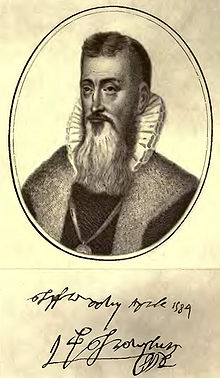Earl of Shrewsbury
Earl of Shrewsbury is a hereditary British title of nobility , bestowed twice in the Peerage of England and named after the city of Shrewsbury in Shropshire .
Awards
First award
The first award went in 1074 to Roger II. De Montgommery, one of the most important advisers to Wilhelm the Conqueror . The title was withdrawn in 1102 when the 3rd Earl, Robert of Bellême rose against Henry I and joined Robert's invasion of Normandy . These Earls of Shrewsbury are also sometimes referred to as the Earl of Shropshire .
Second award
On May 20, 1442, the title was recreated for John Talbot, 7th Baron Talbot , an English general of the Hundred Years War . He had already inherited the titles Baron Talbot (created 1331) and Baron Strange of Blackmere (created 1309) from his ancestors , both in the Peerage of England. He was raised on July 17, 1446 to Earl of Waterford in the Peerage of Ireland and the hereditary Lord High Steward of Ireland . The two earl dignities have since been united.
Before his son inherited him as 2nd Earl in 1453, he had inherited the title of 7th Baron Furnivall created in 1295 by his mother around 1425 , which also became the subordinate title of the Earl dignity.
On the death of the 7th Earl in 1616, who had three daughters but no son, the three old baronies fell into the Abeyance , while the two earl dignities were passed on to the younger brother.
The 12th Earl was an important politician of his time. He was raised to Duke of Shrewsbury and Marquess of Alton on April 30, 1694 in the Peerage of England . Both titles expired when he died childless in 1718. The claim to the two earl dignities fell to his cousin as de iure 13th Earl, a priest who failed to assert the title formally valid, and on his death in 1743 to his nephew, who took the title of 14th Earl again.
After the death of the childless 17th Earl in 1856, there was a long and costly legal battle over the two Earl dignities, which was won by his eleventh uncle Henry Chetwynd-Talbot, 3rd Earl of Talbot in 1858. He already held the titles of 3rd Earl Talbot and 3rd Viscount Ingestre , both from 1784, and 4th Baron Talbot of Hensol (created 1733), all of whom belong to the Peerage of Great Britain .
As Lord High Steward of Ireland, the Earl of Shrewsbury is allowed to wear a white staff at the coronation celebrations of the British monarchs. The Earl of Shrewsbury and Earl of Waterford are Premier Earl on the Rolls of England and Ireland , as the two titles are the oldest earliest dignities of the Peerage of England and Peerage of Ireland, which are listed as the primary title. The older English title of the Earl of Arundel bears the Duke of Norfolk , the older Irish title of the Earl of Kildare bears the Duke of Leinster as a subordinate title.
The Earls' family seat was Alton Towers in Staffordshire until 1924 and is now Wanfield Hall in Staffordshire.
List of the Earls of Shrewsbury
Earls of Shrewsbury, first bestowal (1074)
- Roger de Montgomerie, 1st Earl of Shrewsbury († 1094)
- Hugh of Montgomery, 2nd Earl of Shrewsbury († 1098)
- Robert of Bellême, 3rd Earl of Shrewsbury (1052–1113) (title 1102 revoked)
Earls of Shrewsbury, second bestowal (1442)
- John Talbot, 1st Earl of Shrewsbury , 1st Earl of Waterford (1390-1453)
- John Talbot, 2nd Earl of Shrewsbury , 2nd Earl of Waterford (1413-1460)
- John Talbot, 3rd Earl of Shrewsbury , 3rd Earl of Waterford (1448–1473)
- George Talbot, 4th Earl of Shrewsbury , 4th Earl of Waterford (1468-1538)
- Francis Talbot, 5th Earl of Shrewsbury , 5th Earl of Waterford (1500–1560)
- George Talbot, 6th Earl of Shrewsbury , 6th Earl of Waterford (1528–1590)
- Gilbert Talbot, 7th Earl of Shrewsbury , 7th Earl of Waterford (1552-1616)
- Edward Talbot, 8th Earl of Shrewsbury , 8th Earl of Waterford (1561-1617)
- George Talbot, 9th Earl of Shrewsbury , 9th Earl of Waterford (1567-1630)
- John Talbot, 10th Earl of Shrewsbury , 10th Earl of Waterford (1601–1654)
- Francis Talbot, 11th Earl of Shrewsbury , 11th Earl of Waterford (1623–1667)
- Charles Talbot, 1st Duke of Shrewsbury , 12th Earl of Shrewsbury, 12th Earl of Waterford (1660-1718)
- Gilbert Talbot, de iure 13th Earl of Shrewsbury, de iure 13th Earl of Waterford (1673–1743)
- George Talbot, 14th Earl of Shrewsbury , 14th Earl of Waterford (1719–1787)
- Charles Talbot, 15th Earl of Shrewsbury , 15th Earl of Waterford (1753–1827)
- John Talbot, 16th Earl of Shrewsbury , 16th Earl of Waterford (1791-1852)
- Bertram Talbot, 17th Earl of Shrewsbury , 17th Earl of Waterford (1832-1856)
- Henry Chetwynd-Talbot, 18th Earl of Shrewsbury , 18th Earl of Waterford, 3rd Earl Talbot (1803–1868)
- Charles Chetwynd-Talbot, 19th Earl of Shrewsbury , 19th Earl of Waterford, 4th Earl Talbot (1830–1877)
- Charles Chetwynd-Talbot, 20th Earl of Shrewsbury , 20th Earl of Waterford, 5th Earl Talbot (1860-1921)
- John Chetwynd-Talbot, 21st Earl of Shrewsbury , 21st Earl of Waterford, 6th Earl Talbot (1914–1980)
- Charles Chetwynd-Talbot, 22nd Earl of Shrewsbury , 22nd Earl of Waterford, 7th Earl Talbot (* 1952)
The heir ( Heir apparent ) is the son of the current Earl, James Chetwynd-Talbot, Viscount Ingestre (* 1978).
Individual evidence
Web links
- Shrewsbury entry on Leigh Rayment's Peerage Page
- Shrewsbury, Earl of (E, 1442) at Cracroft's Peerage

